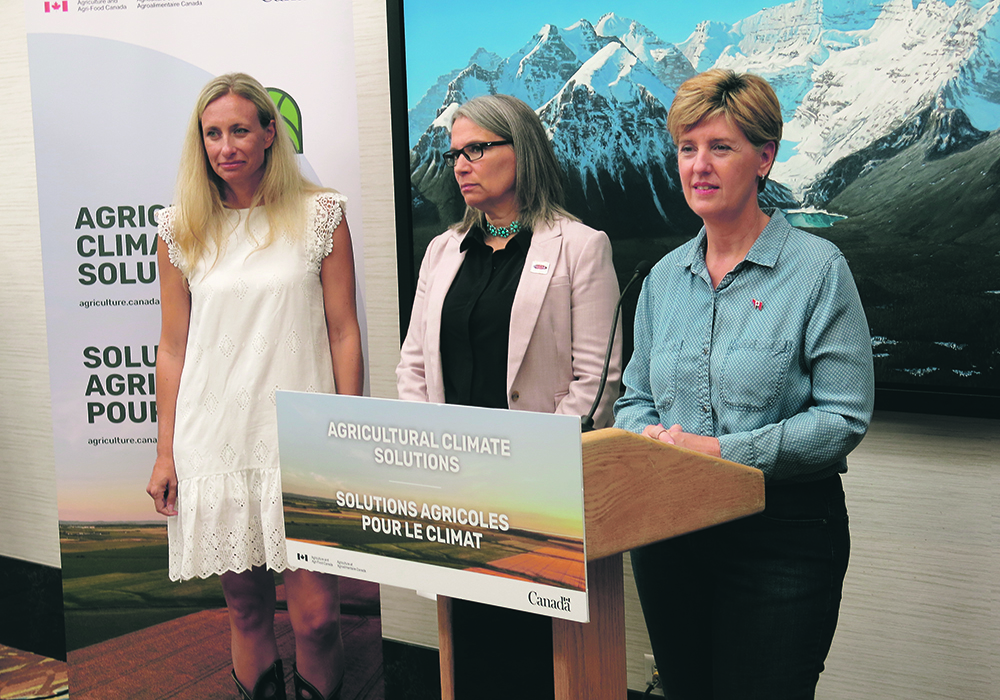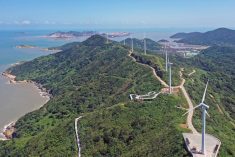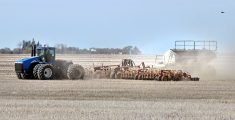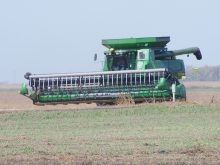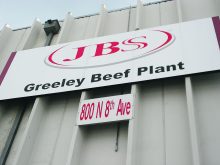A federal initiative that allows producers to join forces with scientists to tackle climate change will provide $54 million to create nine living labs across Canada.
“If we’re going to ask Canadian farmers to feed the world sustainably, they need to get their hands on the right tools as quickly as possible,” said federal agriculture minister Marie-Claude Bibeau. “This innovative and collaborative research approach will help them do just that.”
The living labs will bring together producers, researchers and other collaborators to develop innovative solutions to environmental issues related to agriculture, said a federal statement. Bibeau said two will be created in Alberta, along with one in British Columbia that will also benefit Alberta cattle producers.
Read Also

Trump’s tariffs take their toll on U.S. producers
U.S. farmers say Trump’s tariffs have been devastating for growers in that country.
They will join a network of seven existing labs in Manitoba, Ontario, Quebec and Prince Edward Island, said Mark Redman, chief executive officer of Alberta’s Results Driven Agriculture Research (RDAR) agency.
“We said one lab in P.E.I., we get it, but the amount of land that we have in Alberta, we actually need more,” he said. “So, that’s why we were able to extend the reach, and we’ve got three, which is fantastic news for farmers and fantastic news for the environment.”
Meanwhile, a living lab in Saskatchewan will be the first to be led by Indigenous communities. It will involve the Mistawasis Nehiyawak and Muskeg Lake Cree Nation southwest of Prince Albert, said the federal statement.
“This project will see producers and First Nations work toward a common goal of improving the environment while committing to the protection of Indigenous values, treaties, communities, lands and resources.”
Bibeau said the rest of the living labs will be launched in Newfoundland and Labrador as well as Nova Scotia and New Brunswick.
Living labs offer a made-in-Canada approach “that gets researchers out of the lab and onto real working farms,” she said during a news conference July 14 in Calgary. “Farmers and scientists work side by side in the fields.
“Together, they develop and test practices and technologies that help the farmer protect the environment and grow the business. With living labs, farmers are (not just) consulted, they are out there with the researchers testing solutions in real conditions on real farms across the country.”
Ottawa will be providing more than $16 million for the two living labs in Alberta, said Bibeau. It will fund one led by Alberta Beef Producers, along with another led by the Alberta Conservation Association in partnership with the Food Water Wellness Foundation, she said.
“These projects will focus on key areas such as improving carbon storage through cropping systems, and herd and nutrient management.”
The Peace Region Forage Seed Association will receive $6 million for a living lab that will serve B.C. as well as northern Alberta, said Bibeau. It will work with producers in the Peace River region to improve carbon storage and reduce emissions, she said.
“Across Canada, farmers are on the front lines of climate change and Alberta is no exception. With the drought that has impacted livestock, crops and farmers, we know that partnership is the best way forward on the environment.”
Alberta Beef Producers’ living lab currently involves 16 partners, including agriculture commissions, Indigenous communities, non-government organizations, research institutions and private industry, said chair Melanie Wowk during the news conference. It will benefit the province’s feed, forage and cropping sectors, she said.
Many producers in Alberta have mixed operations where crops are often used for feedgrains and silage, while manure nutrients are used on cropland, she said.
“Improving carbon sequestration and reducing greenhouse gas emissions in one sector has an indirect impact on others when we look at agriculture as an entire system.
“The five-year project aims to increase understanding of how beneficial management practices can contribute to environmental stewardship and enhance climate change resiliency.”
Wowk said it will target six key areas: crop rotation and cropping systems, land use changes, grazing management, livestock feeding, nutrient management, and increasing carbon storage on the whole farm.
“Identifying financial and non-financial barriers faced by producers adopting these beneficial management practices will also be a priority.”
The living lab involving the Food Water Wellness Foundation will expand on the group’s work with farmers, ranchers and researchers, said director Kimberley Cornish during the news conference.
It will help provide agricultural climate solutions that place carbon in soils while reducing greenhouse gas emissions, she said.
It will use techniques such as predictive soil mapping to help identify best management practices that fit local growing conditions faced by farmers while meeting their individual production and environmental goals, she said.
“Through our partnership with the forage and applied research associations, we will be able to capture data on the implementation of these practices across the multitude of ecosystems and growing conditions in Alberta.”


